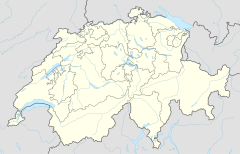Rapperswil Castle
| Schloss Rapperswil | |
|---|---|
 Rapperswil harbour, as seen from Seedamm, Fischmarktplatz to the right, Rapperswil castle and Stadtpfarrkirche (St. John's Church) in the background (September 2014) | |
| General information | |
| Classification | Historic monument |
| Town or city | Rapperswil |
| Country | Switzerland |
| Coordinates | 47°13′38″N 8°48′56″E / 47.227337°N 8.815509°E |
| Construction started | ~ 1220 respectively 1352 |
| Completed | ~ 1229 respectively 1354 |
Rapperswil Castle (Swiss German: Schloss Rapperswil) is a castle, built in the early 13th century by the House of Rapperswil, in the formerly independent city of Rapperswil.
The castle is located on the eastern
Since 1870 the castle has been home to the





Geography
The medieval
The castle is situated next to
History
Rapperswil Castle dates back around 1200 to 1220 AD, and it was first mentioned in 1229 on occasion of the foundation of the
The chapel adjoining the ossuary dates back to the time when the parish passed from the Busskirch church to the Rapperswil church and accordingly an inner city cemetery was established. The first chapel was associated to the castle, but the chapel was located outside of its walls and separated by a trench. The preceding building of the Liebfrauenkapelle was built as an ossuary around 1220 to 1253. The charnel house was first mentioned as intra cymeterium ecclesia, meaning church in the cemetery.
The
In 1350 an attempted coup by the aristocratic opposition (a central person was Count Johann II) in the city of Zürich was forcefully put down, and the town walls of Rapperswil and the castle were destroyed by Rudolf Brun. Eis-zwei-Geissebei, a Carnival festival hold in Rapperswil on Shrove Tuesday, may go back to the siege and destruction of the city of Rapperswil. The battlements and the castle were rebuilt by Albrecht II, Duke of Austria in 1352/54.[2][3]
After the extinction of the line of Habsburg-Laufenburg in 1442, the castle was given to the citizens of Rapperswil. Ending
Over the course of time, the castle fell into disrepair. In 1870 the castle was leased for 99 years from the local authorities by a post-
In 2008 some Rapperswil residents petitioned local authorities to evict the Polish Museum from its home in the castle, as two historical museum locations (
Architecture and points of interest
Building
Rebuilt by Duke Albert II, since 1354 the castle forms an almost equilateral triangle, and each corner of the castle is reinforced with a tower. The highest tower in the southwest is the
-
Legend of founding on a house at Hauptplatz
-
Zeitturm as seen from the south (Hauptplatz)
-
Gügeliturm and Lindenhof as seen from the west
-
Pulverturm and Polish freedom pillar as seen from the north
-
As seen from the cemetery in the east,Liebfrauenkapelle and St. John's Churchto the left
-
relief of the Rapperswil coats of arms over the main portal
-
The castle's main portal and battlements
-
Lower portal, St. John's Church (to the left) and Herrenberg in the background
Interior
Inside the castle's palais, there is located next to the Polish Museum the Schloss Restaurant.[9] After hours visits are available by appointment, as well as guided tours for groups, although the castle is just partially accessible for the public. The impressing Rittersaal (knight's hall) and the historical wooden architecture, as well some pictures and tapestry include further points of interest.
-
Rittersaal in the palas
-
interior view
-
frescos in the donjon
-
Gothic wooden supraporta, now in the Rathaus Rapperswil
Herbal garden
The city and local board of Rapperswil-Jona initiated in 2011 a new service and operating concept for the Rapperswil castle to provide the site as a touristic attraction and meeting place, and thus recognizable as a brand. For this purpose, the tower, the battlements and the herb garden were opened to the public.[10][11]
Lindenhof hill
In 981 AD the assumably oldest
State of research
It is also assumed a predecessor building, a Roman era watchtower in conjunction with the Vicus Centum Prata, but for the present there are no archaeological findings. Due to the structural conditions, there never significant archaeological excavations were carried out, incidentally at the entire area of the Lindenhof and Herrenberg area. Likewise, there are few reliable data for the construction, only the renovations and the function of the castle are therefore secured by historical sources.
Heritage sites of national significance
Rapperswil Castle and the Polish Museum are listed in the
See also
- Lindenhof (Rapperswil)
- Stadtmuseum Rapperswil
- Einsiedlerhaus
References
- ^ a b "Schweizerisches Inventar der Kulturgüter von nationaler Bedeutung: Kanton St. Gallen, A-Objekte" (PDF) (in German). bevoelkerungsschutz.admin.ch. 2015-01-01. Archived from the original (PDF) on 2015-12-19. Retrieved 2015-09-14.
- Staatsarchiv des Kantons Zürich. Retrieved 2015-08-03.
- Staatsarchiv des Kantons Zürich. Retrieved 2015-08-03.
- ^ Pauszer-Klonowska, pp. 466/467.
- ^ "Official Website". The Polish Museum in Rapperswil. Retrieved 2014-11-09.
- ^ "Architektur" (in German). Stadtmuseum Rapperswil-Jona. Retrieved 2014-11-09.
- ^ "Official statement on the Future of the Polish Museum in Rapperswil". The Polish Museum in Rapperswil. Retrieved 2014-11-10.
- ^ "Umstrittenes Polenmuseum soll im Schloss Rapperswil bleiben" (in German). Schweiz aktuell. 2013-03-28. Retrieved 2014-11-10.
- ^ "Schloss Restaurant Rapperswil" (in German). Schloss Restaurant Rapperswil. Retrieved 2014-11-09.
- ^ "Neuer Glanz für Schloss Rapperswil" (in German). Zürcher Oberländer. 2012-11-13. Retrieved 2015-09-27.
- ^ "Beantwortung Petition zum Schloss Rapperswil" (in German). rapperswil-jona.ch. 2012-12-13. Retrieved 2015-09-27.
External links
- Schloss Rapperswil on the website of Rapperswil-Jona (in German)
- Alois Stadler: Rapperswil (SG) in German, French and Italian in the online Historical Dictionary of Switzerland, 16 November 2011.

















